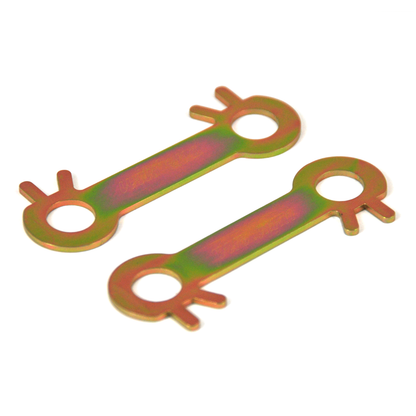NLXTACY
Wits' End
Now time for something a little different...
NOTE: If your knuckle hardware is properly torqued, and not needing a rebuild, there is NO reason to take it apart just to use these. Keep your setup as is until the next rebuild.
At this point in 80 Series Land Cruiser ownership you *should* have heard the term "Check Yer Nuts". This saying refers to your axle's knuckle hardware. They are known to work loose, fall out or sheer which can lead to complete knuckle failure where the steering arm works itself off and the knuckle and tire fold inside the wheel well. It sounds extreme but it occurs way too often. Why does this happen? Is it something defective in the knuckle? The answer is NO.
The reason why they come loose is because either the knuckle wasn't properly rebuilt (simple things can be missed) or from something as simple as re-torquing the knuckle hardware. These are HEAVY DUTY trucks and require constant checking for long term use. You can't just set it and forget it, especially if you are going off pavement at all. In fact, after each off road excursion you should check the knuckle hardware. If this is the first you are hearing of this, well consider it gospel because bad things can happen.
So what do these fancy shmancy "Nut Huggers" do? Well, at minimum all it does is replace the OEM washers that makes up the hardware stack in your knuckles. At its best, when installed properly, they will prevent the knuckle hardware from falling apart and ruining parts.
When you are finally ready to rebuild your axles OR if you notice you are missing/loose hardware, then its the ideal time to utilize these in the rebuild process. You will need to:
• Completely clean and de-grease the mounting surface of the steering arm and knuckle
• Use a sanding block/file to make sure both the knuckle and steering arm surfaces are flat and smooth
• Be sure the knuckle studs are tight in the knuckle itself, the shoulder will prevent the stud from going too far
• Put the steering arm in place with the cone washers
• Place the NUT HUGGER instead of the OEM washers, DO NOT use the OEM washers
• Hand tighten the nut (with the flat edge toward the knuckle)
• Torque the nuts to 71ft lb.
• Do NOT bend the tabs yet
• Drive 500 miles and re-check the torque and verify 71ft lb
• Now go ahead and use a screw driver to bend the tabs up and then use a brass drift and hammer to knock ALL tabs into the knuckle nut to lock it's position in place

 absolute-wits-end.com
absolute-wits-end.com




NOTE: If your knuckle hardware is properly torqued, and not needing a rebuild, there is NO reason to take it apart just to use these. Keep your setup as is until the next rebuild.
At this point in 80 Series Land Cruiser ownership you *should* have heard the term "Check Yer Nuts". This saying refers to your axle's knuckle hardware. They are known to work loose, fall out or sheer which can lead to complete knuckle failure where the steering arm works itself off and the knuckle and tire fold inside the wheel well. It sounds extreme but it occurs way too often. Why does this happen? Is it something defective in the knuckle? The answer is NO.
The reason why they come loose is because either the knuckle wasn't properly rebuilt (simple things can be missed) or from something as simple as re-torquing the knuckle hardware. These are HEAVY DUTY trucks and require constant checking for long term use. You can't just set it and forget it, especially if you are going off pavement at all. In fact, after each off road excursion you should check the knuckle hardware. If this is the first you are hearing of this, well consider it gospel because bad things can happen.
So what do these fancy shmancy "Nut Huggers" do? Well, at minimum all it does is replace the OEM washers that makes up the hardware stack in your knuckles. At its best, when installed properly, they will prevent the knuckle hardware from falling apart and ruining parts.
When you are finally ready to rebuild your axles OR if you notice you are missing/loose hardware, then its the ideal time to utilize these in the rebuild process. You will need to:
• Completely clean and de-grease the mounting surface of the steering arm and knuckle
• Use a sanding block/file to make sure both the knuckle and steering arm surfaces are flat and smooth
• Be sure the knuckle studs are tight in the knuckle itself, the shoulder will prevent the stud from going too far
• Put the steering arm in place with the cone washers
• Place the NUT HUGGER instead of the OEM washers, DO NOT use the OEM washers
• Hand tighten the nut (with the flat edge toward the knuckle)
• Torque the nuts to 71ft lb.
• Do NOT bend the tabs yet
• Drive 500 miles and re-check the torque and verify 71ft lb
• Now go ahead and use a screw driver to bend the tabs up and then use a brass drift and hammer to knock ALL tabs into the knuckle nut to lock it's position in place

80 Series Nut Hugger- Toyota Solid Axle Knuckle
80 Series Nut Hugger- Toyota Solid Axle Knuckle (SAK-1)

